With James Barnard
Springloaded is a Singapore indie game company that started making pixel art games since 2013. Their game Let’s Build a Zoo was released in Nov 2021 and received very positive reviews. James Barnard is the founder of the company who started as a musician, then moved into design and coding. Check out their prior interviews and games.
Q: What is the game Let’s Build a Zoo about? Where can players find the game?
It is a zoo building game where you collect and look after animals! We wanted to make something that was inspired by the original theme park game from Bullfrog, but also modernise it. We wanted to do some brand new things to the genre (like adding morality systems) while also making a game that was bigger, more accessible, and deeper than most other pixel art builders available on the market today.
Currently the game is available on Steam. However, it is coming soon to all consoles!
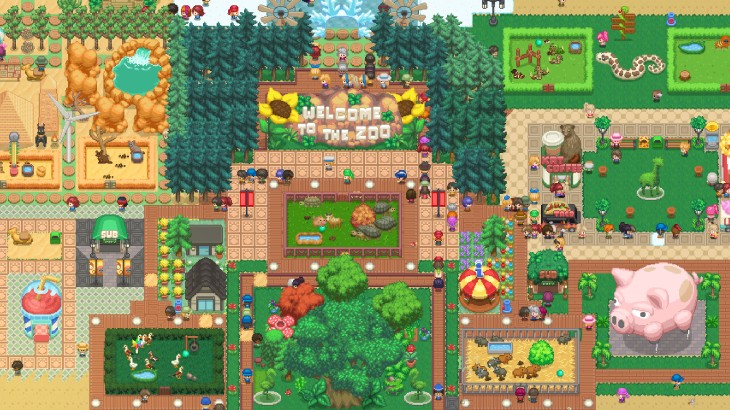
It’s time to build a zoo! Let out your wild side, and create your own animal empire with this cute, expansive management sim.
Q: Give us some details on the preproduction of the game. What inspired the development of this game?
We had made another game using a similar viewpoint, and a friend of ours suggested we should do a ‘zoo version’ of it. It was going to be a free-to-play mobile game, but within just a couple of weeks of development we outgrew that idea. The compromises which we were making to the design and the art just felt too restrictive. I was personally starting to just feel sad working on the game, as all the great ideas that we were discussing were just not suitable for a free-to-play game that is aimed at mass market mobile consumers.
As a result, we decided to just do a Hail Mary, and jumped into making the game we wanted. At that time, we were struggling a little, as our previous games had not really been financially predictable. We had always relied on mobile, but with the growth of aggressive monetisation and ubiquitous user acquisition, it was starting to feel like we could no longer compete in that space. App Stores no longer have the draw they once did, so just ‘making a great game’ and getting a couple of million downloads from featuring is no longer a viable way to run a mobile games business. On the flip side, premium console games have had limited success for us since we are pretty terrible at marketing.
So we decided to develop the game that we wanted to make… even though we did not really have the money to finish it or any faith that we could sell it. We followed our hearts; if this was going to be the last Springloaded game, we wanted to go down making something we were proud of.
Q: The game seems to be a straightforward zoo-building game until players are confronted with weird decision options. What’s up with this zoo?
I love cute happy things, but too much cuteness makes me want to throw up in my mouth! So, we set out to be a bit subversive: How do we twist this cute world towards all kinds of dark and weird directions? There are so many evil things that you could do in a zoo; even the idea of a zoo is an ethical conversation in and of itself. Naturally, many players will just want to never have anything ugly or evil in their zoo, which made it obvious that we should include morality in the game.
Showing players evil options and good ones, allows it to be full of surprises, and always engaging. And for players who only want to be good or morally correct, seeing the evil choices is still entertaining, which is why the moral choice system worked so well.
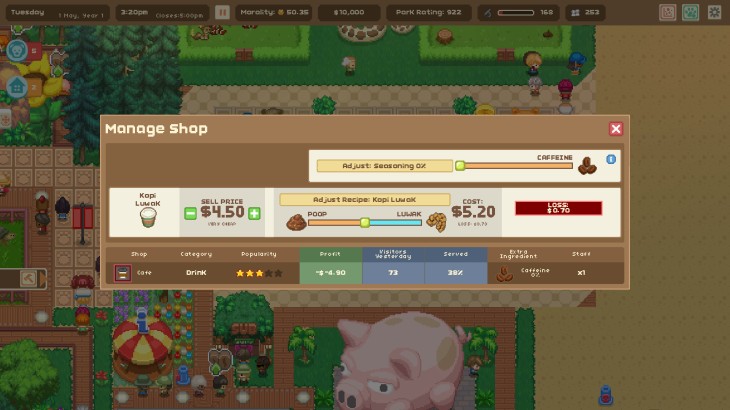
You can manage multiple aspects of your zoo, including the pricing of your food stores.
Q: Let us talk about DNA splicing. How did the team manage to create (and name) over 300,000 different animal combinations?
It was an offhand joke to do hybrids, and then we thought some more and realised it could actually be quite straightforward… I coded the system of merging heads and bodies together pretty quickly, and even the naming system was quite simple. To do the names, we just split all the animal names at a consonant, and glue the two parts together base on the animal. For example, Ele-phant and Ze-bra becomes Zephant or Elebra (I cannot remember if I did the split before or after the consonant – but you get the idea).
With everything apparently working, we thought it was all smooth sailing. However, when we started adding more and more animals there were small alignment issues. This resulted in our artists Cindy and Yvonne spending a looooooong time adjusting the positions so that every animal would look perfect. As you know, after recent updates the game has millions of animals, and they have almost all been seen and adjusted a little bit by our artists. Thankfully, we have ways of making this process easier now by reusing existing archetypes, but there is still some manual checking.
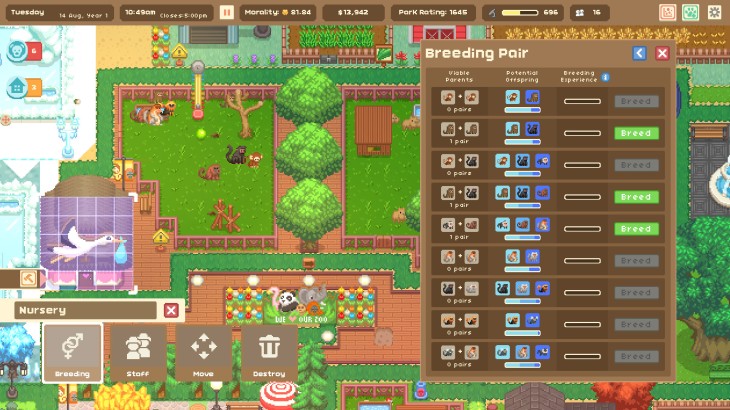
Breed your animals and start families to expand your wildlife and fill your enclosures. But if that doesn’t suit you… you could just create animals instead!
Q: How was development different for this game as compared to your other games?
As we started running low on finances, we reached out to some publishers for help. Unfortunately, everyone rejected the game! So, with the fuel tank on fumes, we carried on working on the game for another 4 months and then tried again.
Much to our delight, the prototype finally demonstrated our vision for the game, and there were emails flooding my inbox with offers to publish the game. We chose No More Robots in the UK, because we felt their games were suitably quirky, and they seem to have a track record of success. They funded the rest of our development and did a great job of letting people know about the game.
So, I guess the answer to what was different is… Well everything. From risking our company, to trying to make the best premium game we could, to working with a publisher, and most importantly to having the financial stability to actually make the game closer to our vision than we normally do.
Q: What mistakes did your team make during development? What about this game you wished could have been done better?
I think we struggled to find the core of the game for a while. I initially thought that the sim should offer a lot of emergent behaviours, and that the world would be running on a million micro simulations. The problem that grew over time was that it was impossible to understand why anything was happening in the game. An animal with too little space and not enough privacy might become depressed and not want to eat, and eventually die. If you could figure out that it was depressed, you could give the animal antidepressants in an attempt to fix things. But the issue was really that – with so much going on, tiny things could stack up to big results.
We determined that players need a clear cause and effect, which lead us to shift the design philosophy to focus on having less stats and systems, as well as taking the ones we do have and exposing them to the players in a transparent manner. The goal that we are still working towards is that every single thing that happens in the game can be understood by looking at the causality path. Players can see the actual data that led to a specific animal being hungry, or the customers being unhappy.
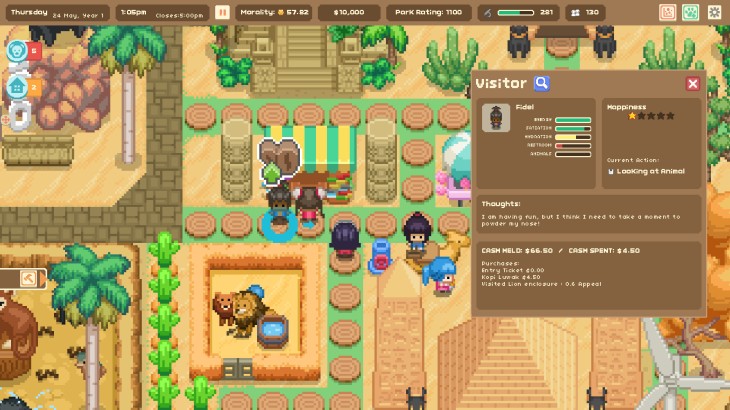
Keep your animals and your visitors happy, with hundreds of buildings, foliage, path and enclosure decorations.
Q: What did you learn from making Let’s Build a Zoo? Or what lessons from previous games did you implement into Let’s Build a Zoo?
Well, we learnt a massive amount, and I can’t wait to make the next one. Along with a better understanding on what modern players want from a sim game, we figured out a pile of technical things. For example, we now have a path finding solution that allows 10,000 NPCs to walk around and pick where they want to go.
I think that the main takeaway is to continue to evolve our processes and technology. This game contains code that I wrote ten years ago sitting in a bar on the beach in Langkawi, which shows you how long we have been developing our framework. Looking forward, we will take our lessons in code architecture and make our projects more modular and reusable. This is really the only way we can grow the size of our projects far beyond what could be achieved by a small team like ours.
Q: How did the team handle marketing and publishing for Let’s Build a Zoo?
Thankfully, we did not really have to do much. Had we launched the game ourselves, I think it would not have been a success. Our publisher No More Robots did a great job of putting the game in front of people’s noses. And looking in, they made it look easy! But I know we could never have achieved such reach, since they have invested years of hard work into building a community. Now that community loves “Let’s Build a Zoo”! Hopefully, they will buy our future games too!
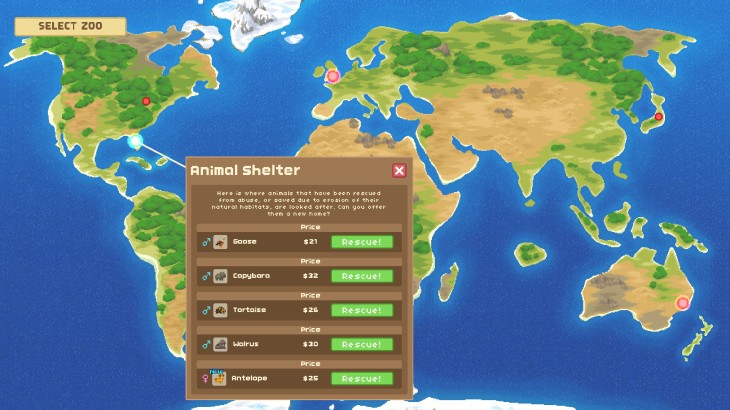
Let’s Build a Zoo lets you import a variety of animals from other Zoos around the world!
Q: What are the future plans for the team?
We want to make a new similar game, and already have designs for several sequels! So, we are really excited to get going on those, but first up we have to finish the console versions of this game, and the DLC.
Even when we start on our next game(s), Let’s Build a Zoo development will not stop – we expect to update the game for the next 5 years! It is amazing to finally have a game that financially supports us well enough to be able to invest in adding new features and polish.
Q: Is there anything else you would like to add about the game?
Please, if you haven’t already, give the game a go! It’s sure to surprise you.

